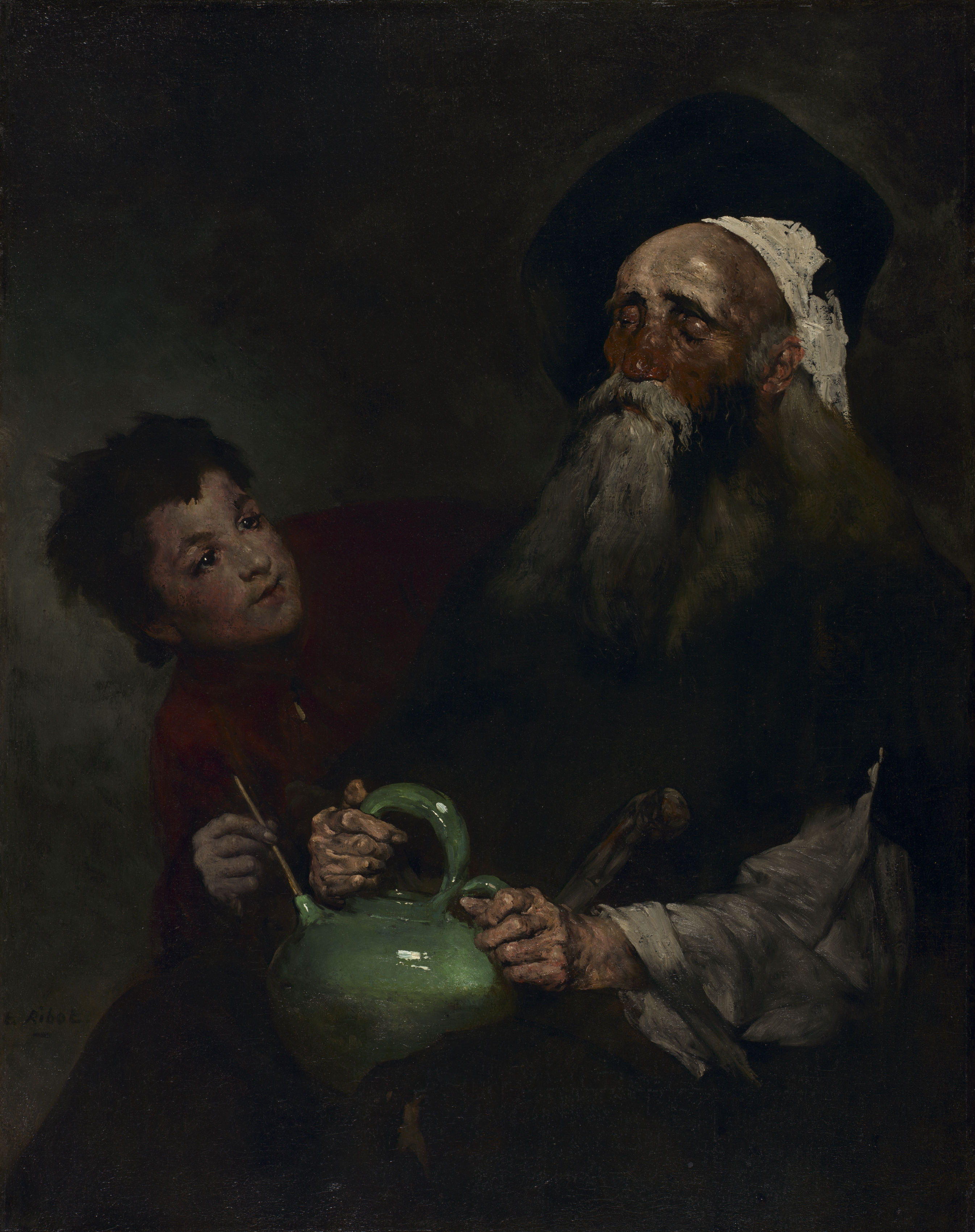The Cleveland Museum of Art
Collection Online as of April 19, 2024

Lazarillo de Tormes and His Blind Master
before 1880
(French, 1823–1891)
Framed: 108 x 90 x 7 cm (42 1/2 x 35 7/16 x 2 3/4 in.); Unframed: 91.5 x 73.7 cm (36 x 29 in.)
Bequest of Noah L. Butkin 1980.282
Location: not on view
Description
The subject of this painting comes from the 16th-century Spanish novel Lazarillo de Tormes. This tells the story of Lazarillo, a poor servant boy who worked for an impoverished blind man. Abused by his master, and never given enough to eat or drink, Lazarillo is forced to fend for himself. According to the story, he steals wine by drinking it from a straw directly from the blind man's jug. This painting relates to a cultural movement known as espagnolisme, the French interest in Spanish art and literature. Especially popular during the 1850s, espagnolisme focused upon realistic, often down-trodden characters such as Lazarillo. Instead of finding them naïve or foolishly humorous, artists such as Ribot related to their alienation from society and found inspiration in the detailed descriptions of their rough, lowly lifestyles.- 1897(E. Oppenheim sale, Hôtel Drouot, May 11, 1897, no. 22, unsold1911(Possibly Bernheim-Jeune, Paris)1918(Sale, Galerie Georges Petit, Paris, December 4-5, 1918, no. 8)1973(Hôtel Drouot, Nov. 7, 1973 [no lot number, reproduced on page 3], sold to Peter Wengraf on behalf of Noah L. and Muriel S. Butkin)1973-1980Noah L. [1918-1980] and Muriel S. Butkin [1915-2008], Cleveland, OH, bequeathed to the Cleveland Museum of Art as a result of disclaimer by Muriel S. Butkin1980-The Cleveland Museum of Art, Cleveland, OHProvenance Footnotes1 "E. Oppenheim" may refer to Eduard Freiherr von Oppenheim of the German banking family. Eduard’s brother Albert von Oppenheim was an avid art collector, whereas Eduard was chiefly interested in horse-breeding and horseracing. He did own works of art, but the archives of the Bankhaus Sal. Oppenheim contain no inventory or correspondence indicating that the Ribot was owned by Eduard or that his collection was sold in 1897 at Hôtel Drouot (Gabriele Teichmann, email to Victoria Sears Goldman, Jan. 5, 2016). According to Hôtel Drouot's annotated copy of the 1897 sale catalogue , the painting failed to sell. In the catalogue, as well as those of the 1918 and 1973 auctions, the CMA painting is titled “L'aveugle et don Guzman d'Alfarache.” After Ribot’s death, the painting acquired this title (“The Blind Man and Don Guzman d’Alfaranche”), a reference to Mateo Alemán’s novel Guzman de Alfarache (1599). The subject of the painting, however, clearly derives from a passage in the earlier novel Lazarillo de Tormes (1554). The discrepancy between title and subject likely stems from the moralizing plot and happier ending of Guzman d’Alfarache, which was apparently more agreeable and memorable to a wider audience.2 A 1911 exhibition of works by Ribot at Bernheim-June includes a painting titled L’Aveugle for which no dimensions or descriptions are provided. The absence of a Bernheim-Jeune stock number on the back of the painting, frame, or stretcher make it difficult to confirm whether or not the CMA picture was the one in the Bernheim-Jeune catalogue.
- Hôtel Drouot. Catalogue de tableaux modernes et dessins. May 11, 1897.Laurence Mille, email to Victoria Sears Goldman, Oct. 27, 2015, in CMA curatorial file.Exposition Ribot. Paris: Bernheim-Jeune, 1911.
Galerie Georges Petit. Catalogue des tableaux modernes par Bail, Berchère, Boudin, Jules Breton, Cazin, Chaplin... Dec. 4-5, 1918.Hôtel Drouot. Tableaux anciens et du XIXe siècle, objets d'art et d'ameublement, meubles et sièges anciens. Nov. 7, 1973.Peter Wengraf, letter to Mlle. Harranger, Nov. 13, 1977, in CMA curatorial file.Estate of Noah L. Butkin, Bequests to Cleveland Museum of Art as a result of disclaimer by Murel S. Butkin. Estates, Gifts, and Funds, Series 1, Box 2:14. Cleveland Museum of Art Archives.Peter Wengraf, letter to Mlle. Harranger, Nov. 13, 1977, in CMA curatorial file.Argencourt, Louise d', and Roger Diederen. Catalogue of Paintings. Pt. 4. European Paintings of the 19th Century. Cleveland: Cleveland Museum of Art, 1974. Mentioned and reproduced: P. 546-548, Vol. II, no. 192Delapierre, Emmanuelle. "Paysages." In Théodule Ribot, 1823-1891: Une Délicieuse Obscurité. Emmanuelle Delapierre, Luc Georget, Gabriel Weisberg, eds., 182-193. Paris: LienArt, 2021. Mentioned and reproduced: P. 218-219, no. 80 - Théodule Ribot (1823-1891): A Delightful Darkness. Musée des Augustins, Toulouse, France (October 16, 2021-January 2, 2022) https://www.augustins.org/en/exhibition-theodule-ribot; Musée des Beaux-Arts, Marseille, Marseille, France (February 10-May 15, 2022); Musée des Beaux-Arts de Caen, Caen, France (organizer) (June 11-October 2, 2022) https://mba.caen.fr/exposition/theodule-ribot.Manet/Velázquez: The French Taste for Spanish Painting. The Metropolitan Museum of Art, New York, NY (organizer) (February 25-June 29, 2003).The Metropolitan Museum of Art (2/25/2003 - 6/8/2003): "Manet/Velazquez: The French Taste for Spanish Painting", exh. cat. no 198, p.518, fig. 14.80, p. 400.Year in Review: 1980. The Cleveland Museum of Art (organizer) (June 24-July 19, 1981).Paris, Galeries de L'Art. Th. Ribot, Exposition Générale de ses oeuvres (1880), not in cat. (according to Weisberg 1976).Paris, Galerie Bernheim Jeune. Exposition T. Ribot (1890), 19, L'aveugle à la cruche verte et l'enfant, app. à M. Oppenheim; 55, no. 227 bis, L'aveugle, app. à M. Oppenheim.Possibly Paris, Bernheim Jeune & Cie. Exposition Ribot (2-8 February 1911), no. 24, L'aveugle.
- {{cite web|title=Lazarillo de Tormes and His Blind Master|url=false|author=Théodule Ribot|year=before 1880|access-date=19 April 2024|publisher=Cleveland Museum of Art}}
Source URL:
https://www.clevelandart.org/art/1980.282